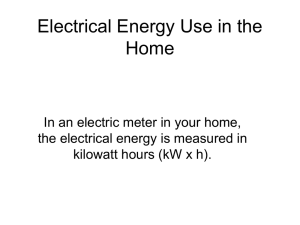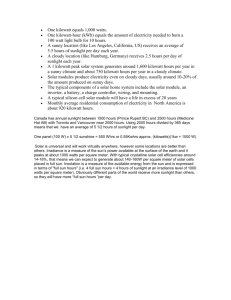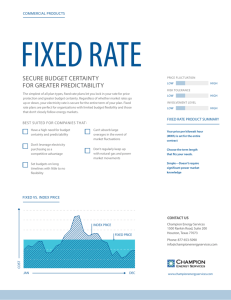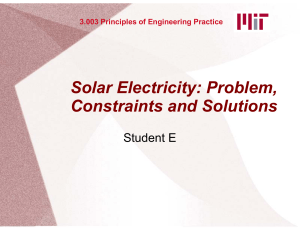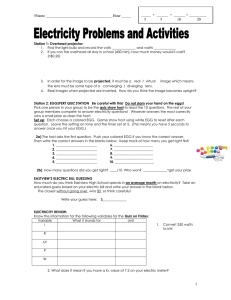ALTERNATIVE ENERGY SOURCES
advertisement
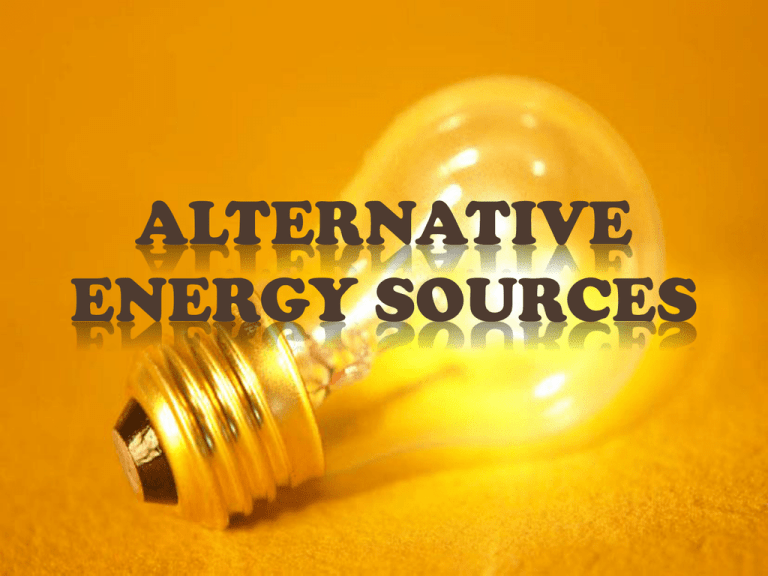
ALTERNATIVE ENERGY SOURCES THE EAST GROUP OF ENERGIZERS Chris Sims Tina Smith Derek Studards Tyler Quinn Instructor Dianne Phillips Environmental Geology WHAT HARM DOES ELECTRICITY DO TO THE ENVIRONMENT? Electricity generation is the leading cause of industrial air pollution in the U.S. Most of our electricity comes from coal, nuclear, and other fossil fuels power plants. Electricity generation is responsible for: 38% of the nation's carbon dioxide (CO2), a greenhouse gas and major contributor to climate change. 66% of the nation's sulfur dioxide (SO2) when combined with rain water, creates acid rain. 40% of the nation's mercury contributes to contamination of soil and waterways. 25% of nitrogen oxides (NOx), which react with sunlight to create ground level ozone and smog. Representative Countries & Energy Usages, 2002 Country Population in Millions Energy Consumption in quadrillion China India 1295 1050 126 .6 kilowatt hour 30.7 kilowatt hour United States 288 285 .7 kilowatt hour Brazil Pakistan Russia Bangladesh Japan Nigeria Mexico Germany France United Kingdom Italy South Korea Canada 176 150 144 144 128 121 102 82 60 59 57 47 31 25.2 kilowatt hour 52.7 kilowatt hour 80 .5 kilowatt hour 1.7 kilowatt hour 64.4 kilowatt hour 2.6 kilowatt hour 10.6 kilowatt hour 32.6 kilowatt hour 27.3 kilowatt hour 2.78 kilowatt hour 2.27 kilowatt hour 2.46 kilowatt hour 13.4 kilowatt hour ENERGY USAGE BY STATE State Name 1. Wyoming 2. Kentucky 3. South Carolina 4. Alabama 5. Louisiana 6. Tennessee 7. Idaho 8. Indiana 9. Arkansas 10. Mississippi kWh (million) Estimated Population Per Capita Electricity Use (kWh) 12,950 494,118 26,208 79,975 4,067,781 19,661 74,832 4.061.209 18,426 79,234 4,468,031 17,734 74,681 4,466,532 16,720 95,320 5,748,038 16,583 21,096 1,321,228 15,967 97,734 6,127,732 15,949 41,732 2,692,134 15,501 44,287 2,858,325 15,494 ENERGY CONSUMPTION BY HOUSEHOLD Households consume 1/5 of total energy in US American households used approximately 866kilowatt hours per month in 1999 costing them $70.68. The typical U.S. family spends almost $1,500 a year on utility bills. About 60 percent is in the form of electricity; the remainder comes mostly from natural gas and oil. SOLAR POWER PANELS One of the most valuable and environmentally-friendly sources of energy is solar power. How do solar panels work? The sun is collected by the silicon that is located on these panels. The UV rays make the electrons that are located in the silicon move around. As this movement takes place, the energy begins to form. After this occurs, the energy is then moved out of the panels and into a battery or other kind of collector. SOLAR POWER PANEL ADVANTAGES 1. Saves you money After the initial investment is recovered, energy from the sun is practically free The savings are immediate and for many years to come. 2. Environmentally friendly Solar Energy is clean, renewable (unlike gas, oil and coal) and sustainable, helping to protect our environment. It does not pollute our air by releasing carbon dioxide, nitrogen oxide, sulfur dioxide or mercury into the atmosphere like many traditional forms of electrical generations does. 3. Independent/ semi-independent Solar Energy can be utilized to offset utility-supplied energy consumption. It not only reduces your electricity bill, but will also continue to supply your home/ business with electricity in the event of a power outage. A Solar Energy system can operate entirely independent, not requiring a connection to a power or gas grid at all. 4. Low/ no maintenance Solar Energy systems are virtually maintenance free and will last for decades. Once installed, there are no recurring costs. They operate silently, have no moving parts, do not release offensive smells and do not require you to add any fuel. WIND POWER As the wind flows past the rotors of a wind turbine, the rotor spins and drives the shaft of an electric generator. Running the wind power along with adding the utility grid costs can range from $15,000 to more than $50,000 per mile, depending on terrain. WIND POWER ADVANTAGES 1. Saves You Money Wind energy is one of the lowest-priced renewable energy technologies available today, costing between 4 and 6 cents per kilowatt-hour Wind energy systems involve a significant initial investment, but can be competitive with conventional energy sources when you account for a lifetime of reduced utility costs 2. Good For The Environment Wind energy is fueled by the wind, so it's a clean fuel source Wind Energy is widely distributed and also reducing toxic gas emissions. 3. Wind Generating The World By 2020, wind-generated electricity is projected to satisfy the residential needs of 195 million Europeans—half of the region's population. The United Kingdom is requiring an investment of over $12 billion in off-shore wind farms that should satisfy the residential electricity needs of 10 million of the country's 60 million people. Tiny Denmark, which led Europe into the wind era with the development of its own wind resources, now gets an impressive 20 percent of its electricity from wind. Germany overtook the United States in terms of wind-based generating capacity in 1997. Now Spain is close to overtaking the United States as well. YEARLY ELECTRICITY COSTS VS RENEWABLE RESOURCE COSTS Electricity Burns Hall $285,600.57 Student Center $272,500.00 Parking Garage $46,072.60 Total: $604,173.17 Solar Power *Yearly Electricity Costs For All NWACC Buildings: $718,366.20 Wind Power TECHNOLOGIES USED Internet PowerPoint Cell Phone COMMUNITY CONTACTS -Gerry Weatherford- GWEATHER@nwacc.edu 1-479-619-3100 -Purchasing Department of NWACC -Jim Lay- development and expansion- jlay@nwacc.edu 1-479-619-4130 -Dean Galloway- knows future NWACC plans- mgallowa@nwacc.edu 1-479-619-4158 -Deborah Deville- ddeville@nwacc.edu provided annual energy costs - Jennifer Elam- Western Regional Sales Manager at GroSolar jennifer@grosolar.com BIBLIOGRAPHY http://www.energy.ca.gov/electricity/us_perca pita_electricity_2001.html http://www.spheralsolar.com/solarpanels.html http://www.eia.doe.gov/kids/energyfacts/sour ces/renewable/solar.html http://www.eere.energy.gov/states/us_energy_ statistics.cfm http://www.energy.ca.gov/electricity/us_perca pita_electricity_2001.html TIMELINE November 1, Research NWACC costs of energy, find out prices of alternative sources, make contacts November 11-13th, Finish PowerPoint, finish webpage, December 1, Finalize proposal, finish project and report http://faculty.nwacc.edu/EAST_original/Environ mental%20Geology2007/Alternative%20Fuels, %20Fall%202007a.htm Power point
